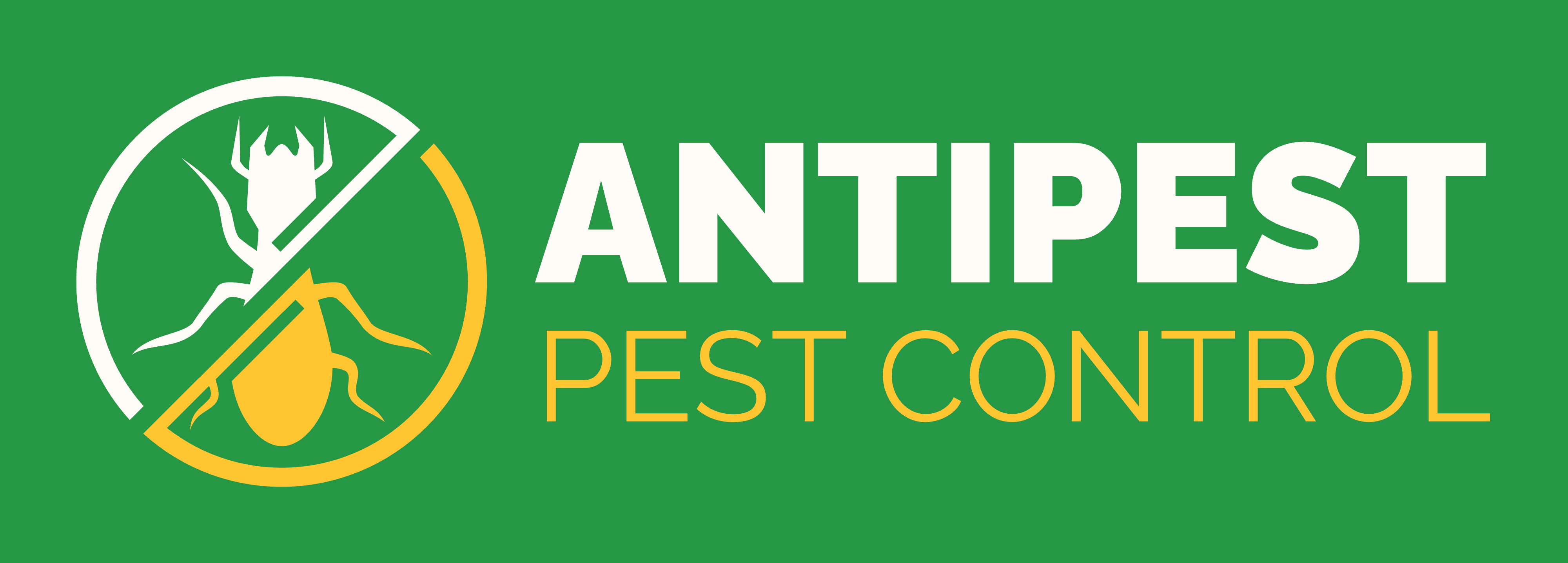Sugar ants might be tiny, but their ability to find every crumb and invade your kitchen often leaves homeowners frustrated. If you’ve entered your kitchen to see a parade of sugar ants marching towards a syrup spill or crawling near your sink, you’re not alone. Wondering how to get rid of sugar ants fast and keeping them out for good isn’t just a matter of cleanliness, understanding their behavior and knowing effective methods are key.
Understanding how to get rid of sugar ants effectively requires knowing their behavior, identifying what attracts them, and implementing proven elimination strategies. This guide addresses how to get rid of sugar ants, why they show up, prevention tips, and answers your most pressing questions.
Table of Contents
What are Sugar Ants?
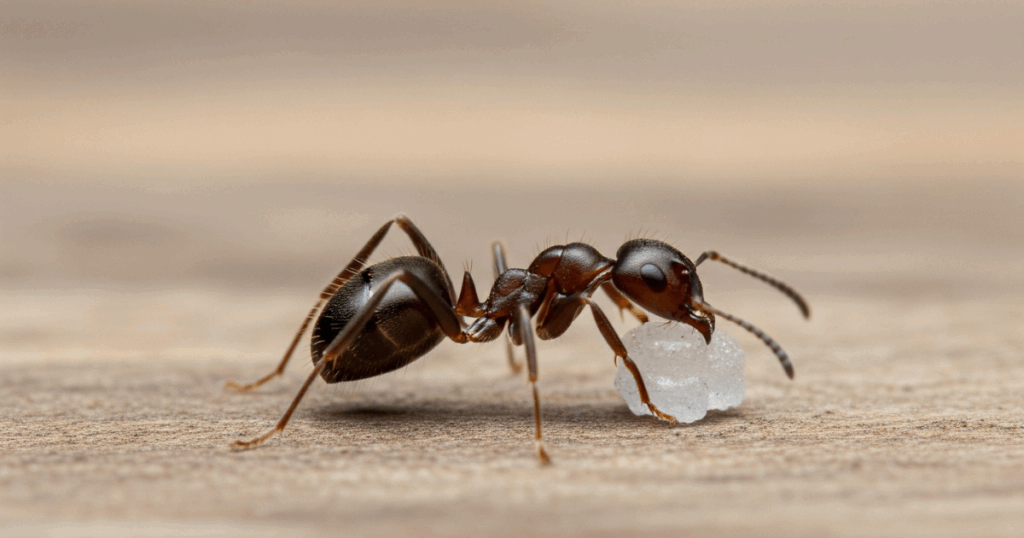
Sugar ants aren’t a single species; the term is commonly used to describe any small ant attracted to sweets, including odorous house ants, pavement ants, and banded sugar ants. In Australia, the true sugar ant is Camponotus consobrinus, but Americans use “sugar ants” to refer to several household ants seeking sugary food. These ants vary in appearance but are often small and black or brown.
Sugar ants thrive in urban settings, forests, and gardens. In homes, they’re notorious for heading straight for sweet substances, sugar, honey, fruit, soda, or the residue of treats in trash bins. They communicate by leaving scent trails, which attracts more ants to newly found food sources. Their adaptability and resourcefulness make “how to get rid of sugar ants” a frequent concern for homeowners.
| Characteristic | Description |
| Size | 2-3 millimeters |
| Color | Dark brown to black |
| Body Structure | Three segments: head, thorax, abdomen |
| Colony Size | Hundreds to thousands of individuals |
| Lifespan | Workers: 2-3 months, Queens: up to 1 year |
What Attracts Sugar Ants to Your House?
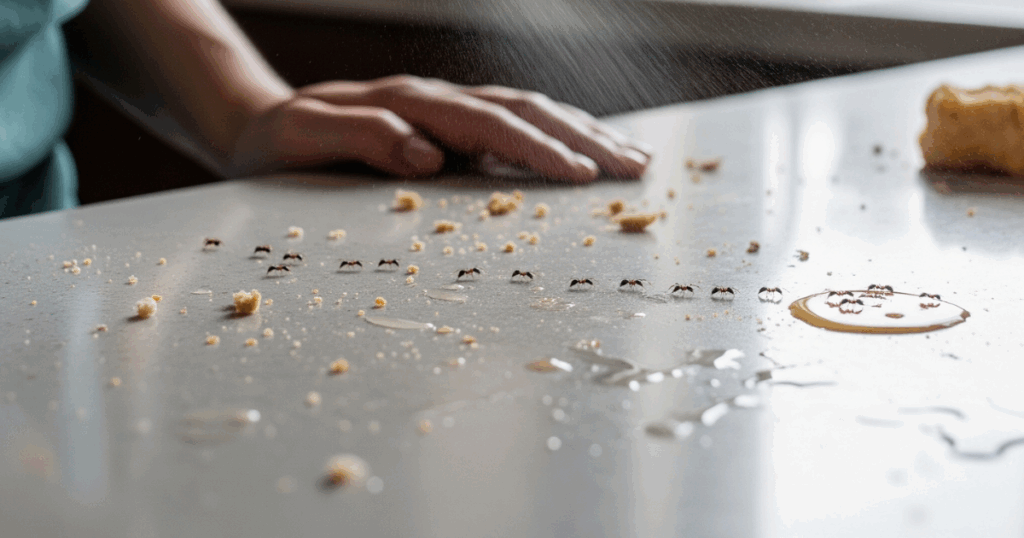
Sugar ants are skilled foragers. They’re drawn to homes by:
- Sugary spills and crumbs on counters, floors, and inside cabinets.
- Unsealed food containers, especially those storing sweets, syrups, and jams.
- Pet food and water bowls left out overnight.
- Moisture and leaks: Ants require water and will seek it in bathrooms, under sinks, or around potted plants.
- Plant secretions and honeydew from aphids living on houseplants.
- Trash bins with remnants of sweet foods or drinks.
A single ant scout can lead an entire colony once it finds a food or water source, so even one stray ant should prompt immediate action.
Top 5 Sugar Ant Magnets in the Home
| Area/Item | Reason for Attraction | Prevention Tip |
| Kitchen Counter | Crumbs, spills, exposed sugar | Wipe after use, store food airtight |
| Trash Bin | Sweet food residues | Empty regularly, use sealed bins |
| Pet Food Bowl | Proteins, sweeteners | Clean after feeding, no overnight |
| Bathroom Sink | Moisture | Fix leaks, keep dry |
| Houseplants | Aphid honeydew, moisture | Inspect for pests, wipe leaves |
Discover safe, natural and effective ways on How to Remove Ants from Garden – read the full guide here.
How to Get Rid of Sugar Ants? – 10 Effective Methods
Getting rid of sugar ants requires combining cleaning, natural repellents, and targeted baits. Here’s how to get rid of sugar ants using proven strategies:
1. Clean Thoroughly and Remove Food Sources
The foundation of how to get rid of sugar ants lies in eliminating their food supply. Wipe down all surfaces with soapy water, paying special attention to areas where food is prepared or consumed. Clean inside appliances, under refrigerators, and behind stoves where crumbs accumulate. Store food in airtight containers and immediately clean up spills or crumbs.
2. Use Natural Ant Deterrents
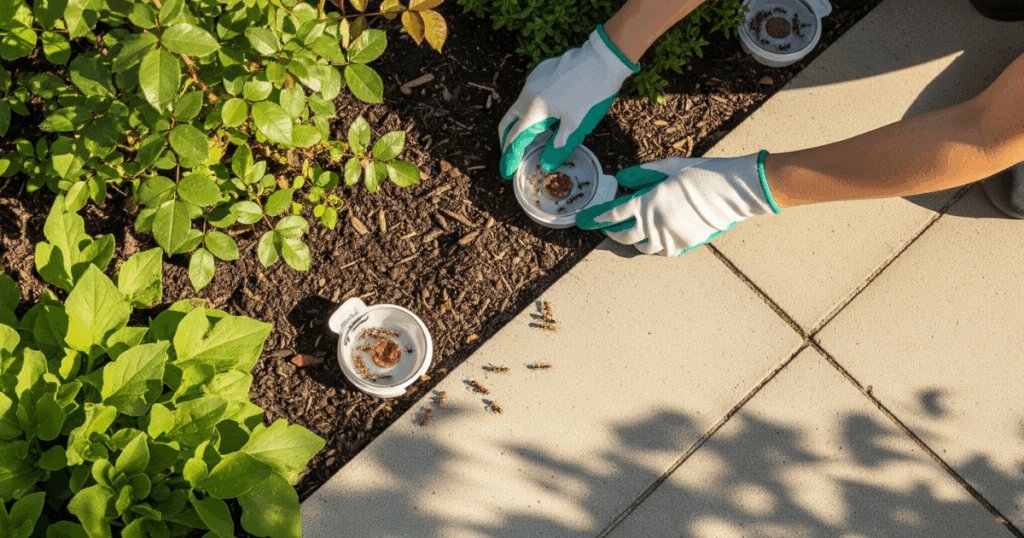
Several household items effectively repel sugar ants without toxic chemicals. Cinnamon, coffee grounds, and diatomaceous earth create barriers that ants avoid. Spray vinegar solutions along ant trails to disrupt their scent markers. Essential oils like peppermint, tea tree, and lemon create natural boundaries when applied to entry points.
3. Deploy Ant Baits Strategically
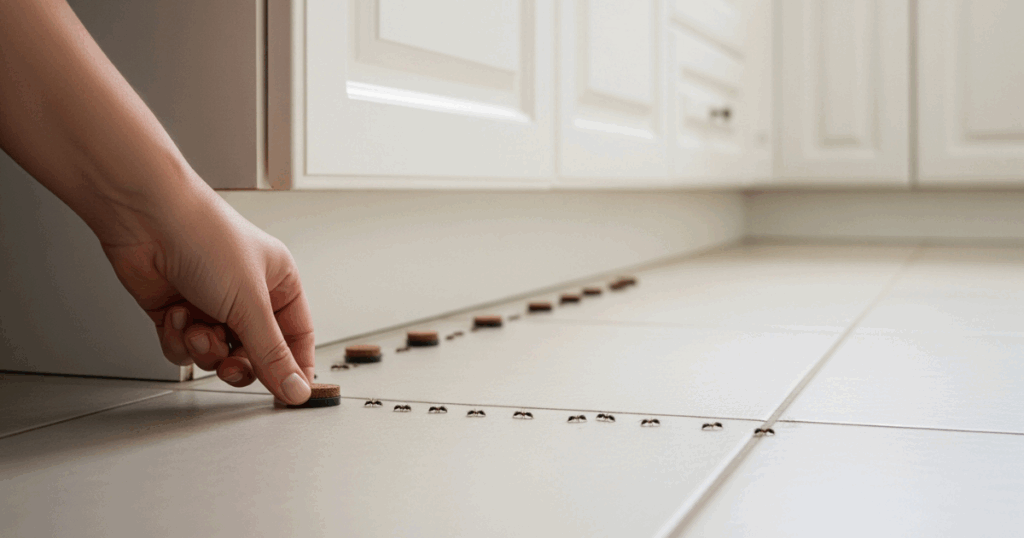
Commercial ant baits work by attracting worker ants who carry poisoned food back to their colony. Place baits along established ant trails and near entry points, but keep them away from children and pets. The process takes several days as the poison spreads throughout the colony, eventually reaching the queen.
4. Seal Entry Points
Inspect your home for cracks, gaps, and openings that allow ant access. Use caulk to seal spaces around windows, doors, and pipes. Install door sweeps and weather stripping to eliminate gaps under doors. Check foundation walls for cracks that need repair.
| Entry Point | Sealing Method |
| Window frames | Silicone caulk |
| Door gaps | Weather stripping |
| Pipe openings | Expanding foam |
| Foundation cracks | Concrete crack filler |
5. Create Chalk Barriers
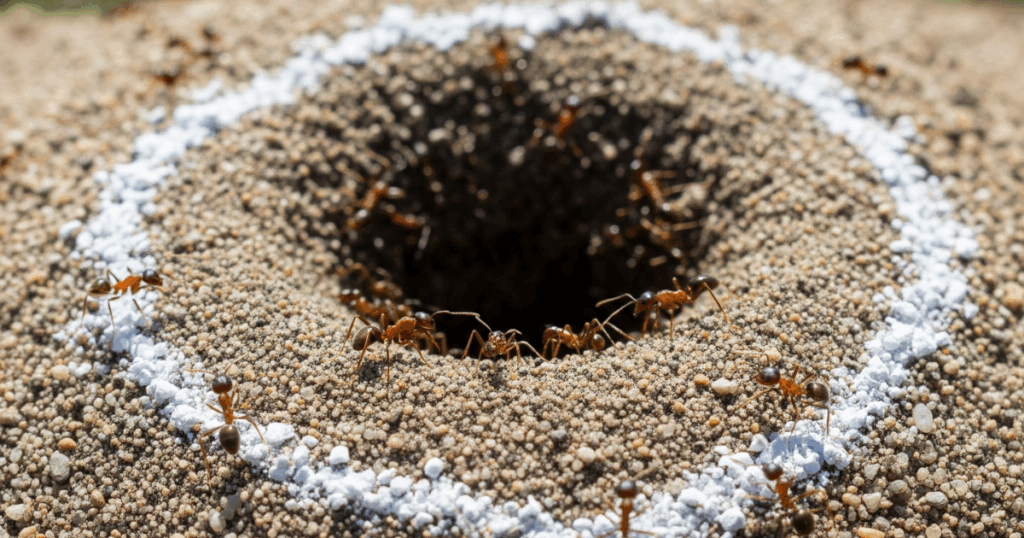
Chalk contains calcium carbonate, which disrupts ant navigation systems. Draw chalk lines around entry points, along baseboards, and across ant trails. This method provides temporary deterrence and works best when combined with other elimination strategies.
6. Apply Boric Acid Treatments
Boric acid mixed with sugar creates effective homemade ant bait. The sweet smell attracts ants while the boric acid eliminates them. Place small amounts near ant trails, but exercise caution around pets and children as boric acid can be harmful if ingested.
7. Use Cornmeal as Natural Control
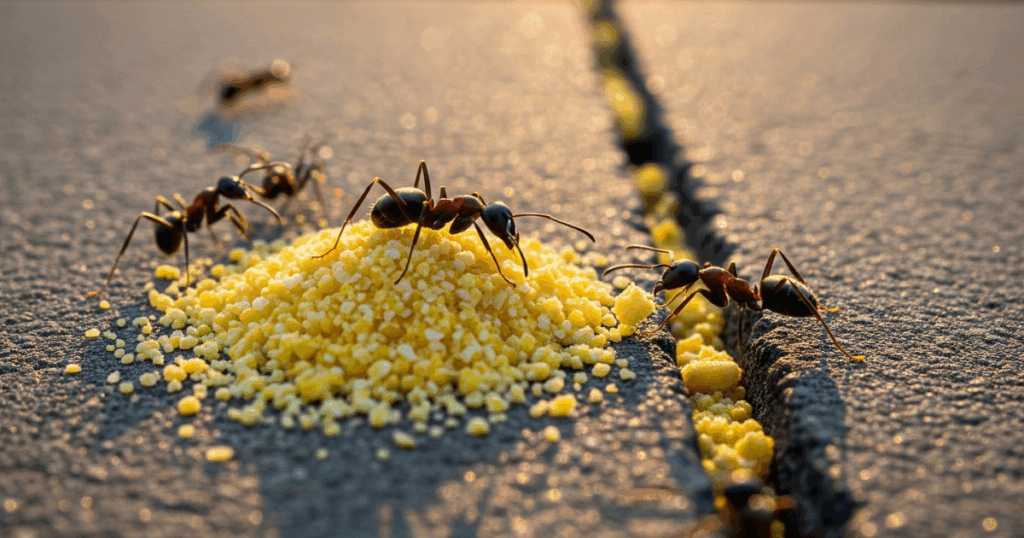
Cornmeal expands in ant digestive systems, providing a natural elimination method. Sprinkle cornmeal along ant trails and near nest entrances. This approach takes longer than chemical methods but offers a safer alternative for households with pets or children.
8. Deploy Coffee Ground Barriers
Used coffee grounds repel ants due to their acidity and strong scent. Spread coffee grounds around entry points, along windowsills, and near ant trails. Replace the grounds regularly to maintain effectiveness, and consider combining this method with other deterrents.
9. Implement Diatomaceous Earth Treatment

Food-grade diatomaceous earth damages ant exoskeletons, leading to dehydration. Apply thin layers along ant paths and around nest areas. This method requires patience as effects aren’t immediate, but it provides long-lasting protection when properly applied.
10. Professional Pest Control Services
When infestations persist despite home remedies, professional exterminators offer specialized treatments. They can identify ant species, locate nest sites, and apply targeted treatments that provide faster, more complete elimination. Professional services often include follow-up treatments and prevention advice.
Struggling with ants in your food? 👉 Learn safe ways to remove ants from rice here.
Preventing Sugar Ants from Returning
Once you’ve learned how to get rid of sugar ants, prevention is critical to keep your home ant-free:
- Daily Cleaning: Wipe surfaces and sweep floors, especially after meals.
- Store Food Properly: Keep sweets and starches in sealed containers.
- Fix Leaks: Repair plumbing issues and reduce moisture sources.
- Maintain Trash Areas: Use tightly sealed bins and empty them frequently.
- Check Pet Areas: Clean bowls immediately after feeding and store pet food securely.
- Monitor Entry Points: Regularly check for new cracks and reseal as needed.
- Inspect Houseplants: Control aphids and other pests that secrete honeydew.
Taking proactive steps ensures sugar ants don’t find new ways to invade your home.
Preventative Actions for Sugar Ant Control
| Action | Frequency | Impact on Ants |
| Wipe counters | Daily | Removes food cues, trails |
| Fix leaks | As needed | Reduces water sources |
| Empty trash | Every 1–2 days | Eliminates food attractants |
| Clean pet bowls | After each meal | Avoids attraction to proteins/sugars |
| Seal entry points | Monthly check | Blocks future infestations |
How to Get Rid of Sugar Ants? – Natural vs. Chemical Solutions
When deciding how to get rid of sugar ants, choosing between natural and chemical approaches requires careful consideration of your household’s specific needs and safety requirements.
Natural Methods
Natural approaches to how to get rid of sugar ants prioritize safety and environmental responsibility. These methods work well for families with young children, pets, or individuals with chemical sensitivities who need gentler alternatives.
Key advantages of natural solutions:
- Safe around children and pets
- Environmentally friendly ingredients
- No toxic residue concerns
- Cost-effective using household items
- Sustainable long-term approach
Common natural methods include:
- Vinegar sprays to disrupt scent trails
- Essential oil barriers (peppermint, tea tree)
- Diatomaceous earth applications
- Coffee ground deterrents
- Cinnamon and chalk barriers
Chemical Solutions
Chemical treatments offer faster, more comprehensive elimination when learning how to get rid of sugar ants effectively. Professional-grade products can penetrate deep into colonies and nest sites that natural methods cannot reach.
Benefits of chemical approaches:
- Rapid colony elimination
- Access to hidden nest locations
- Complete eradication of established infestations
- Professional-strength formulations
- Immediate visible results
However, chemical solutions require:
- Careful application following label instructions
- Safety precautions around family members
- Proper ventilation during treatment
- Storage away from children and pets
| Approach | Timeline | Safety Level | Effectiveness | Cost |
| Natural Methods | 1-2 weeks | High | Moderate | Low |
| Chemical Solutions | 3-7 days | Moderate | High | Medium |
| Combined Approach | 1-2 weeks | High | Very High | Medium |
What If Sugar Ants Keep Appearing?
Even after you try the best ways for how to get rid of sugar ants, persistent infestations may require additional measures:
- Track Their Entry: Watch ant trails to locate their source and the colony’s nest.
- Rotate Repellents: Use different natural deterrents to avoid resistance.
- Consult Professionals: Severe infestations can be eliminated with expert help.
Remember, the longer you wait, the larger the colony and the more difficult it may be to completely get rid of sugar ants.
Complete Ant Control Solution: Sugar Ants, Carpenter Ants, and Fire Ants
While learning how to get rid of sugar ants, many homeowners discover they’re dealing with multiple ant species simultaneously. A comprehensive approach addresses all common household ant problems together, saving time and ensuring complete property protection.
Identifying Different Ant Species in Your Home
Understanding the differences between ant species helps you choose the most effective treatment approach when figuring out how to get rid of sugar ants and other varieties.
| Ant Type | Size | Color | Primary Threat | Treatment Priority |
| Sugar Ants | 2-3mm | Dark brown/black | Food contamination | Medium |
| Carpenter Ants | 6-13mm | Black/dark red | Structural damage | High |
| Fire Ants | 2-6mm | Reddish-brown | Painful stings | High |
Multi-Species Treatment Strategy
When dealing with multiple ant species while learning how to get rid of sugar ants, prioritize treatments based on threat level. Address structural-damaging carpenter ants first, followed by dangerous fire ant, then focus on sugar ant elimination.
Integrated Treatment Approach:
- Use professional-grade baits that target multiple species
- Apply perimeter treatments around your entire property
- Seal entry points to prevent all ant types
- Maintain consistent sanitation standards
- Monitor and treat outdoor nest locations
“Stop ALL ant problems at once! Whether you’re dealing with sugar ants in your kitchen, carpenter ants damaging your home, or fire ants threatening your family’s safety – our comprehensive ant control solution eliminates every species. Struggling with flying ants? Discover quick fixes that actually work! Call now for a complete property assessment and multi-species treatment plan that protects your home year-round!”
Conclusion
Sugar ants can be persistent, but with a systematic approach, identifying what attracts them, applying proven remedies, and implementing preventative measures, you can reclaim your kitchen and home. Regular cleaning, sealing entry points, and using safe DIY traps ensure that when the question arises of how to get rid of sugar ants, you’re fully prepared to act. Don’t let these tiny invaders disrupt your home, take control with this guide on how to get rid of sugar ants and enjoy a pest-free space.
For comprehensive and hassle-free sugar ant removal and long-term pest prevention, trust the professionals at Antipest Office. Visit us at the Antipest Office, Our trained technicians use safe and effective methods to protect your home and business. For service bookings and consultations, call us at +91 9819018398 .
How to Get Rid of Sugar Ants? – FAQs
How to get rid of sugar ants naturally without chemicals?
Use vinegar sprays, diatomaceous earth, and cinnamon barriers. Clean thoroughly and seal entry points. Natural methods take 1-2 weeks but are pet-safe.
How to get rid of sugar ants permanently from my home?
Use ant baits with borax, seal entry points, maintain cleanliness, and eliminate moisture. Professional treatment may be needed for severe infestations.
How to get rid of sugar ants quickly in the kitchen?
Apply ant baits along trails, clean with vinegar, and store food in sealed containers. Results appear within 3-7 days.
How to get rid of sugar ants without harming pets?
Use diatomaceous earth, vinegar sprays, coffee grounds, and pet-proof bait stations. Avoid toxic chemicals in pet areas.
How to get rid of sugar ants from entering my house?
Seal cracks with caulk, install door sweeps, eliminate outdoor food sources, and create barrier treatments around your home’s perimeter.
How to get rid of sugar ants using household items?
Mix borax with sugar, spray vinegar, sprinkle cinnamon or coffee grounds. These disrupt trails and eliminate colonies effectively.
How to get rid of sugar ants that keep coming back?
Find and treat nest locations, improve sanitation, seal gaps, reduce moisture, and use professional treatments targeting entire colonies
How to get rid of sugar ants in my bedroom safely?
Remove food sources, vacuum thoroughly, apply diatomaceous earth, and seal entry points near windows and baseboards.
How to get rid of sugar ants during different seasons?
Spring: seal entry points. Summer: control moisture. Fall: remove outdoor attractants. Winter: focus on indoor food storage.
How to get rid of sugar ants when home remedies fail?
Contact professional pest control for species identification, nest location, and targeted treatments with stronger formulations.

